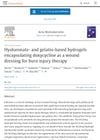Dual-Response Hydrogel System Coordinating Immunomodulation and Tissue Repair for Promoting Infected Burn Wound Healing
January 2025
in “
ACS Materials Letters
”

TLDR The hydrogel system improves healing in infected burn wounds by reducing inflammation and promoting tissue repair.
The study presents a dual-response hydrogel system designed to enhance healing in infected burn wounds, particularly those complicated by multidrug-resistant bacteria. Traditional hydrogel dressings often target only one phase of the healing process, but this GelMA-based hydrogel system addresses both the inflammatory and proliferative stages. It effectively reduces hyperinflammatory infiltration and promotes neovascularization, hair follicle regeneration, and collagen deposition. This innovative approach offers a comprehensive solution for managing challenging wounds, aligning with clinical needs for improved healing outcomes.

